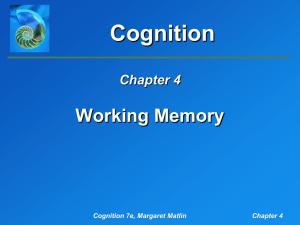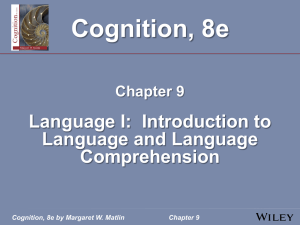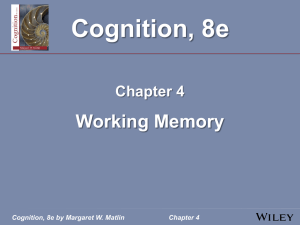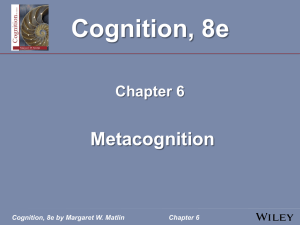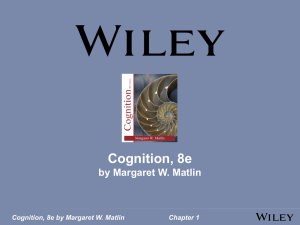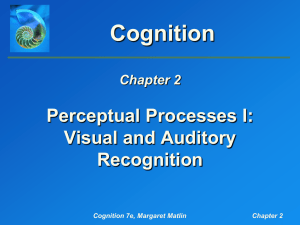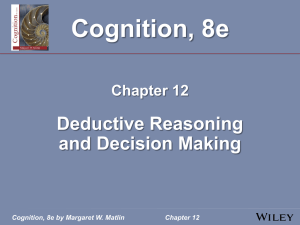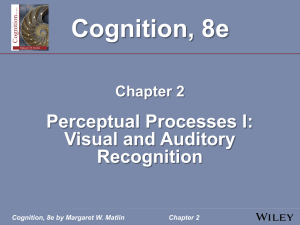Introduction to Language and Language Comprehension
advertisement
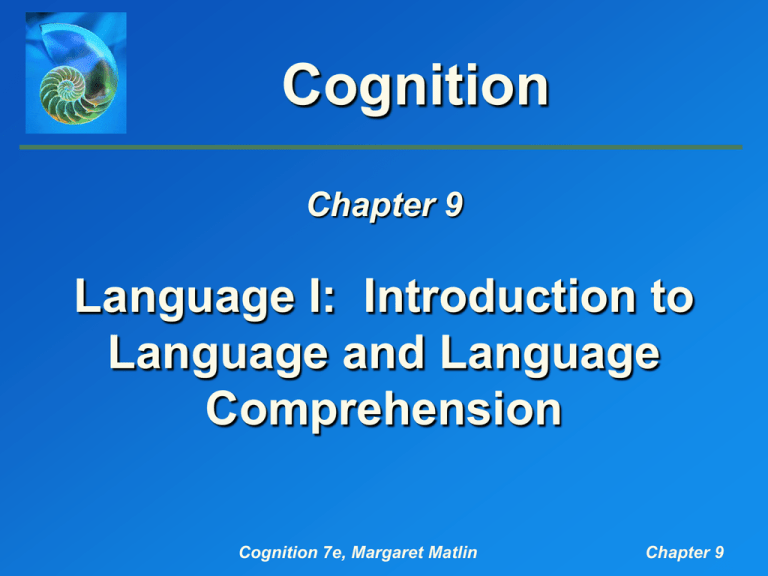
Cognition Chapter 9 Language I: Introduction to Language and Language Comprehension Cognition 7e, Margaret Matlin Chapter 9 Introduction human language is probably one of the most complex processes to be found anywhere on our planet psycholinguistics Cognition 7e, Margaret Matlin Chapter 9 The Nature of Language phoneme morpheme syntax grammar semantics pragmatics Cognition 7e, Margaret Matlin Chapter 9 The Nature of Language Pragmatics - Social Language Use the context of communication Components of communication (speech acts) Locution — the literal meaning of an utterance Illocution -- the intention of the speaker Perlocution -- how it was received by the listener Direct: Locution = Illocution: “Please turn on the light.” Indirect: Locution ≠ Illocution: “It is getting dark in here.” ”Let’s go for a coffee” (indirect request) “I have class” (Iindirect rejection) Cognition 7e, Margaret Matlin Chapter 9 The Nature of Language A Caution: Psycholinguistics Is EnglishCentered 6,000-7,000 spoken languages languages differ in terms of: • • • • the meaning of changes in pitch use of passive voice whether nouns have grammatical gender brain processing Cognition 7e, Margaret Matlin Chapter 9 The Nature of Language Background on the Structure of Language phrase structure constituents nouns verbs working memory Cognition 7e, Margaret Matlin Chapter 9 Constituents Cognition 7e, Margaret Matlin Chapter 9 Phrase Structure Cognition 7e, Margaret Matlin Chapter 9 Phrase Schema “The small dog will bark loudly.” The Nature of Language A Brief History of Psycholinguistics Chomsky's Approach • • • • • language abilities explained in terms of a complex system of rules and principles represented in the minds of speakers humans have innate language skills language is modular (language is special, not processed the same as other cognitive tasks) surface structure vs. deep structure of sentences ambiguous sentences Cognition 7e, Margaret Matlin Chapter 9 The Nature of Language A Brief History of Psycholinguistics Reactions to Chomsky's Theory • • • • early enthusiasm and later revisions research failed to support the prediction that people would take longer to process sentences requiring numerous transformations later theories provided constraints on language learner's inborn knowledge information conveyed in individual words Cognition 7e, Margaret Matlin Chapter 9 The Nature of Language A Brief History of Psycholinguistics Psycholinguistic Theories Emphasizing Meaning emphasis on human mind rather than on structure of language semantics Cognition 7e, Margaret Matlin Chapter 9 The Nature of Language A Brief History of Psycholinguistics Psycholinguistic Theories Emphasizing Meaning Cognitive-Functional Approach (usage-based linguistics)—Tomasello • the function of human language in everyday life is to communicate meaning to other individuals • cognitive processes intertwined with language comprehension and production • children use flexible strategies to create increasingly complex language • adults use language strategically Cognition 7e, Margaret Matlin Chapter 9 The Nature of Language Factors Affecting Comprehension Negatives negative statements require more processing time than affirmative statements “It was never the case that Mr. Jones was not incompetent.” ‘Few people strongly deny that the world is not flat.” p. 196 affirmative statements produce fewer errors The Passive Voice active form of a sentence is easier to understand than the passive form The Nature of Language Factors Affecting Comprehension Nested Structures can result in memory overload Ambiguity Ambiguous Words people pause longer when they are processing an ambiguous word when people encounter a potential ambiguity, the activation builds up for all the well-known meanings of the ambiguous item “Rose took her money to the bank and threw it in the water.” Cognition 7e, Margaret Matlin Chapter 9 The Nature of Language Factors Affecting Comprehension Ambiguity Ambiguous Words People are likely to choose one particular meaning 1. if that meaning is more common than the alternate meaning 2. if the rest of the sentence is consistent with that meaning Cognition 7e, Margaret Matlin Chapter 9 The Nature of Language Factors Affecting Comprehension Ambiguity Ambiguous Sentence Structure • wandering down the wrong path • we can usually understand ambiguous language, but we respond more quickly and more accurately when the language is straightforward Cognition 7e, Margaret Matlin Chapter 9 The Nature of Language In Depth: Neurolinguistics Neurolinguistics Individuals with Aphasia aphasia Broca's area/Broca's aphasia—expressive-language deficit Wernicke's area/Wernicke's aphasia—receptivelanguage deficit both kinds of aphasia can decrease grammatical accuracy Cognition 7e, Margaret Matlin Chapter 9 Broca’s Area & Wernicke’s Area Cognition 7e, Margaret Matlin Chapter 9 The Nature of Language In Depth: Neurolinguistics Hemispheric Specialization Lateralization Right-handed = 95% left hemisphere Left-haded = 50-50 the left-hemisphere's role in language the right-hemisphere's role in language the hemispheres working together Cognition 7e, Margaret Matlin Chapter 9 The Nature of Language In Depth: Neurolinguistics the left-hemisphere's role in language Understanding speech Determining meaning and cause-effect relationships Processing verbal/written images Cognition 7e, Margaret Matlin Chapter 9 The Nature of Language In Depth: Neurolinguistics the right-hemisphere's role in language Interpret emotional tone of speech Understand humor and non-obvious relationships Cognition 7e, Margaret Matlin Chapter 9 The Nature of Language In Depth: Neurolinguistics Neuroimaging Research with Normal Individuals functional magnetic resonance imaging (fMRI) left temporal lobe Gernsbacher and Robertson (2005)—"A"/"The" study virtually identical patterns of activation in left hemisphere right hemisphere response differently to connected language ("the" sentences) than to disconnected language ("a" sentences) Cognition 7e, Margaret Matlin Chapter 9 Basic Reading Processes Reading requires virtually every cognitive process Reading is remarkably efficient and accurate Many challenges including (in English) irregular pronunciations due to lack of one-to-one correspondence between alphabet and speech sounds (phonemes) Cf Spanish, Turkish Cognition 7e, Margaret Matlin Chapter 9 Basic Reading Processes Comparing Written and Spoken Language 1. Reading is visual and is spread out across space, whereas speech is auditory and is spread out across time. 2. Readers can control the rate of input, whereas listeners usually cannot. 3. Readers can re-scan the written input, whereas listeners must rely much more heavily on their working memory. Cognition 7e, Margaret Matlin Chapter 9 Basic Reading Processes Comparing Written and Spoken Language 4. Writing is relatively standardized and error free, whereas variability, errors, sloppy pronunciation, and interfering stimuli are common in speech. 5. Writing shows discrete boundaries between words, whereas speech does not. 6. Writing is confined to the words on a page, whereas speech is supplemented by additional auditory cues—such as stressed words and variations in pace—that enrich the linguistic message. Cognition 7e, Margaret Matlin Chapter 9 Basic Reading Processes Comparing Written and Spoken Language 7. Children require elaborate teaching to master written language, whereas they learn spoken language very easily. 8. Adults who can read tend to learn new words more quickly when they appear in a written form, rather than a spoken form. Cognition 7e, Margaret Matlin Chapter 9 Basic Reading Processes Comparing Written and Spoken Language • Both written and spoken language require us to understand words and appreciate the meaning of sentences. • For adults, scores on reading comprehension tests are highly correlated with scores on oral comprehension tests Cognition 7e, Margaret Matlin Chapter 9 Basic Reading Processes Discovering the Meaning of Unfamiliar Words Context perceiving familiar words resolving the meaning of ambiguous words discovering the meaning of unfamiliar words Cognition 7e, Margaret Matlin Chapter 9 Basic Reading Processes Discovering the Meaning of Unfamiliar Words Sternberg and Powell (1983) • context can provide several kinds of information cues about the meaning of an unknown word (e.g., when and where an unknown item occurs) • words that appear in a rich context of different cues are more likely to be accurately defined Cognition 7e, Margaret Matlin Chapter 9 Basic Reading Processes Discovering the Meaning of Unfamiliar Words Sternberg and Powell (1983) (continued) • large individual differences • ability to use contextual cues and provide accurate definitions for unfamiliar words correlated with tests of vocabulary, reading comprehension, and general intelligence Cognition 7e, Margaret Matlin Chapter 9 Basic Reading Processes Reading and Working Memory • readers who have a relatively large workingmemory span can quickly process ambiguous sentences • people with large working-memory spans are especially skilled in reading difficult passages and solving complex verbal problems • working memory helps us to understand complicated sentences Cognition 7e, Margaret Matlin Chapter 9 Basic Reading Processes Two Pathways for Reading Words How do we look at a pattern of letters and actually recognize that word? Dual-route approach to reading—skilled readers employ both a direct-access route (recognize word directly through vision) and an indirectaccess route (recognize word by first sounding out the word) Cognition 7e, Margaret Matlin Chapter 9 Basic Reading Processes Two Pathways for Reading Words Research on the Dual-Route Approach Bradshaw and Nettleton (1974)—direct-access approach • pairs of words with similar spelling, but different sounds • read first word silently and then pronounce second word out loud • no interference indicated by no hesitation in pronouncing second word • suggests that we do not silently pronounce each word during normal reading Cognition 7e, Margaret Matlin Chapter 9 Basic Reading Processes Two Pathways for Reading Words Research on the Dual-Route Approach Luo and coauthors (1998)—indirect-access approach • pairs of words judged related or unrelated in meaning • students made errors on pairs where the second word sounds like a word that is semantically related to the first word (e.g., LION-BARE) • suggests they were silently pronouncing the word pairs when they made the judgments • few errors on pairs where the second word looked like a related word (e.g., LION-BEAN) Cognition 7e, Margaret Matlin Chapter 9 Basic Reading Processes Two Pathways for Reading Words Research on the Dual-Route Approach Word sounds may be especially important when children begin to read. Children with high phonological awareness have superior reading skills. Children vs. adults—tongue twisters Cognition 7e, Margaret Matlin Chapter 9 Basic Reading Processes Two Pathways for Reading Words Research on the Dual-Route Approach Dual-route Approach • flexible • argues that the characteristics of the reading material determine whether access is indirect or direct • argues that characteristics of the reader also determine whether access is indirect or direct • individual differences Cognition 7e, Margaret Matlin Chapter 9 Basic Reading Processes Two Pathways for Reading Words Implications for Teaching Reading to Children Whole-word approach (direct access) • argues readers can directly connect the written word—as an entire unit—with the meaning that this word represents • argues that children should not learn to emphasize the way a word sounds • emphasizes context within a sentences • problem—even skilled adult readers achieve only about 25% accuracy when they look at an incomplete sentence and guess which word is missing Cognition 7e, Margaret Matlin Chapter 9 Basic Reading Processes Two Pathways for Reading Words Implications for Teaching Reading to Children Phonics approach (indirect access) • readers recognize words by trying to pronounce the individual letters in the word • "sound it out" • argues that speech sound is a necessary intermediate step in reading • emphasizes developing children's awareness of phonemes • phonics training helps children who have reading problems Cognition 7e, Margaret Matlin Chapter 9 Basic Reading Processes Two Pathways for Reading Words Implications for Teaching Reading to Children Most educators and researchers support some sort of compromise Whole-language approach—reading instruction should emphasize meaning, and it should be enjoyable, to increase children's enthusiasm about learning to read. The issue of basic literacy Cognition 7e, Margaret Matlin Chapter 9 Understanding Discourse discourse—language units larger than a sentence Frederick Bartlett's research importance of context, general background knowledge, expertise, scripts, and schemas Cognition 7e, Margaret Matlin Chapter 9 Understanding Discourse Forming an Integrated Representation of the Text How do we gather information together and remember the various concepts to form an integrated and stable message? subtle linguistic cues (e.g., "A" vs. "The") p. 302 mental models (e.g., of a character in a story) Cognition 7e, Margaret Matlin Chapter 9 Understanding Discourse Drawing Inferences During Reading make an inference during reading—draw on our world knowledge in order to activate information that is not explicitly stated in a written passage Cognition 7e, Margaret Matlin Chapter 9 Understanding Discourse Drawing Inferences During Reading The Constructionist View of Inferences Constructionist view of inferences—readers usually draw inferences about the causes of events and the relationships between events Cognition 7e, Margaret Matlin Chapter 9 Understanding Discourse Drawing Inferences During Reading The Constructionist View of Inferences Huitema and coauthors (1993) brief story far/near placement of test sentence from statement of goal consistent/inconsistent relationship between goal and test sentence measure reading time for test sentence reading time longer for inconsistent statements Cognition 7e, Margaret Matlin Chapter 9 The Constructionist View of Inferences Figure 9.3 Amount of Time Taken to Read the Crucial Line in the Study by Huitema and colleagues (1993) Cognition 7e, Margaret Matlin Chapter 9 Understanding Discourse Drawing Inferences During Reading The Constructionist View of Inferences Readers • try to connect material within a text passage • consult information stored in long-term memory • try to construct an internally consistent representation Cognition 7e, Margaret Matlin Chapter 9 Understanding Discourse Drawing Inferences During Reading Factors That Encourage Inferences individual differences failure to activate relevant information working-memory capacity metacomprehension skills expertise scientific texts Cognition 7e, Margaret Matlin Chapter 9 Understanding Discourse Drawing Inferences During Reading Higher-Level Inferences mental preferences for a particular outcome may interfere with judgments about how the story actually turned out Cognition 7e, Margaret Matlin Chapter 9 Understanding Discourse Teaching Metacomprehension Skills metacomprehension—your thoughts about comprehension Contemplating your own reading strategies relevant background knowledge reading every sentences vs. skimming monitoring your understanding noticing when your mind wanders Cognition 7e, Margaret Matlin Chapter 9 Understanding Discourse Teaching Metacomprehension Skills Teaching students to • • • • think out loud summarize make predictions describe puzzling sentences Cognition 7e, Margaret Matlin Chapter 9 Understanding Discourse Individual Differences: Test Anxiety and Reading Comprehension • • high test anxiety and poor test performance thought intrusions Cognition 7e, Margaret Matlin Chapter 9 Understanding Discourse Individual Differences: Test Anxiety and Reading Comprehension Cassady (2004)—test anxiety as decreasing students' skills in understanding the information in their textbooks • • • • read several paragraphs from a textbook two times Cognitive Test Anxiety scale multiple-choice test on textbook material repeat with different material and study-skills survey Cognition 7e, Margaret Matlin Chapter 9 Understanding Discourse Individual Differences: Test Anxiety and Reading Comprehension Cassady (2004) (continued) • people who were highly anxious tended to perform poorly on the reading-comprehension test • people who were highly anxious tended to report poorer study skills • study skills not strongly correlated with scores on the multiple-choice test Cognition 7e, Margaret Matlin Chapter 9 Understanding Discourse Individual Differences: Test Anxiety and Reading Comprehension People with high scores on the Cognitive Test Anxiety scale also made more errors in summarizing textbook material and more errors on a test of ability to make correct inferences. Cognition 7e, Margaret Matlin Chapter 9 Understanding Discourse Artificial Intelligence and Reading artificial intelligence—the area of computer science that attempts to construct computers that can demonstrate human-like cognitive processes natural language—ordinary human language with all its sloppiness, ambiguities and complexities Cognition 7e, Margaret Matlin Chapter 9 Understanding Discourse Artificial Intelligence and Reading The FRUMP Project FRUMP—Fast Reading Understanding and Memory Program • summarize newspaper stories by applying scripts • humans draw numerous inferences that artificial intelligence systems cannot access Cognition 7e, Margaret Matlin Chapter 9 Understanding Discourse Artificial Intelligence and Reading More Recent Projects Landauer and colleagues—latent semantic analysis (LSA) • • • • • • perform sophisticated language tasks provide tutoring sessions grade essays cannot match human grader cannot assess creativity masters just a small component of language comprehension Cognition 7e, Margaret Matlin Chapter 9


